X Marks the spot
Home in on winter bass by locating these surefire structures on a lake map
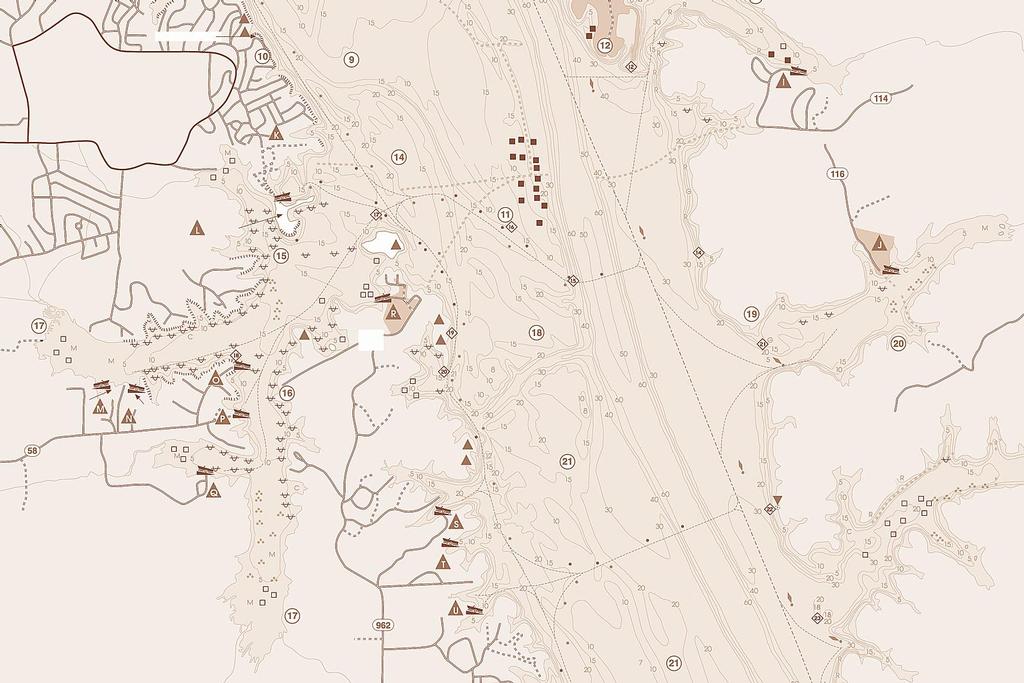
(Editor’s note: This article originally appeared in the 2013 Winter issue of Bass Fishing magazine. To read more compelling articles from Bass Fishing magazine each month, become an FLW subscriber member. If you’d like to sign up for a digital subscription to access articles online, click here).
Two things stand out about winter bass fishing: The fish get a little bit pickier about where they want to be, and anglers don’t want to spend as much time running a bass boat around a frigid lake trying to find them.
Thankfully, the key to overcoming both is a good map and some expert knowledge on what to look for. Here, pros Ron Shuffield and Michael Neal, both avid winter bass anglers, share their advice on how to map out reservoir bass when the mercury plummets.
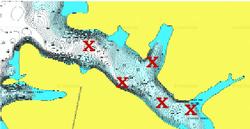 Reservoir Type: Highland” border=”1″ align=”left” />Target area: Channels and deeper holes in the backs of creeks
Reservoir Type: Highland” border=”1″ align=”left” />Target area: Channels and deeper holes in the backs of creeks
Reservoir type: Highland
Situational analysis: Water temperature is relative to region. In Ron Shuffield’s part of the Ozarks, the “winter bite” kicks in when the water temperature reaches about 53 degrees, usually spanning from the middle of December through February.
“I think a lot of bass follow a migratory movement, chasing bait in the fall, and they pull back out into the channels and stay in deeper holes in the wintertime,” Shuffield says. “Depth is relevant to the type of water in the immediate area. The very back of a creek might have a channel swing that’s 5 to 10 feet deep on top and 15 or 20 feet deep in the bottom, but it could be as shallow as 2 or 3 feet deep on top and 8 or 10 in the channel. It might only be a 15- to 20-foot-wide creek or a feeder ditch that courses through a flat area. What matters most is that there is a depth change.”
Attack plan: Hard, rocky bottom substrate and baitfish are the essential ingredients. Fish might set up anywhere along a creek channel, but Shuffield begins his search on outside bends. If he strikes out on the outside bends, he moves to inside bends, especially where scattered cover exists for bass to ambush prey.
“Some days they’re on the inside, usually when actively feeding, but they’re bunched up more on outside turns,” Shuffield explains. “You get better numbers on outside turns, but the bigger ones are near stumps or wood or rock on the inside turns.”
Winter weaponry: Sunny, windy days pull bass up into the water column and get them active. That calls for slightly more aggressive fishing. Shuffield picks up a Bill Lewis Rat-L-Trap, Yo-Zuri Rattl’n Vibe lipless crankbait or a Bandit Series 200 or 300 crankbait and winds it with a “medium retrieve” along the edges of the channels and bends. The lipless lure is his go-to when grass is present too. When the bite is slower, twitch or dead-stick a jerkbait or drag a jig.
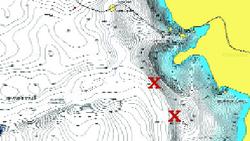 Reservoir Type: Highland” border=”1″ align=”left” />Target area: Steep-dropping main-lake channel swings
Reservoir Type: Highland” border=”1″ align=”left” />Target area: Steep-dropping main-lake channel swings
Reservoir type: Highland
Situational analysis: Again, a channel is the key, but this time Shuffield starts in the main body of the reservoir.
“Look for places where the river channel moves toward the bank and courses back out,” Shuffield says. “It may not be real close to the shoreline, but you can see on the map that it made a swing.”
Attack plan: Shuffield focuses less on the inside of a main-lake bend and more on finding the sweet spot on the outside bend.
“Look for where the channel made a turn toward that bank,” he says. “There’s usually one section of it where you seem to always get the bites. A map will often show you that particular stretch of 10 to 20 yards – look where it swings in and then swings back away.”
Shuffield likes drops that fall quickly. On some of his best he can hold the boat over 90 feet and cast up into 20. However, he does notice that bass linger in the 20- to 40-foot-deep range in winter on lakes he frequents, so he tries to use presentations that target the 15- to 40-foot strike zone.
Winter weaponry: Shuffield drags a 3/8-ounce Stan Sloan’s Zorro Bait Company Booza Bug jig slowly along the bottom when bass show preference for a finesse presentation, which is usually on overcast days. When the sun shines or the wind blows, bass tend to suspend. Hopping – not full-fledged stroking – a jig down the break and controlling it on the fall with slight line tension will get the lure into the strike zone. And don’t drop your guard when the jig finally pulls away from the edge toward the end of the retrieve.
“They’re real bad to suspend just off the face of those breaks,” Shuffield says. “If you’re hopping a jig or dragging, most of the bites come right on top of the lip or after it swings off like a pendulum.”
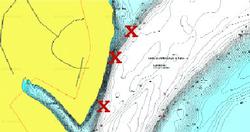 Reservoir Type: Lowland/big river” border=”1″ align=”left” />Target area: Channel-swing banks and bluff banks
Reservoir Type: Lowland/big river” border=”1″ align=”left” />Target area: Channel-swing banks and bluff banks
Reservoir type: Lowland/big river
Situational analysis: Water temperatures in the mid-40s signal the start of the winter bite in Michael Neal’s part of the country in east Tennessee. He looks for traditional lowland reservoir winter structure in the form of a main-lake or creek-channel bluff wall or any steep-dropping bank where the channel swings up along shore.
“It seems like the main river is a little bit better in the wintertime, but if right inside the creek you’ve got a good bluff bank channel swing, especially if you have a lot of current, they’ll get inside the creek,” he says. “If the river is muddy and the creek is clear they’ll get in there.
“I like the clearest water I can find in the wintertime,” Neal adds.
The final keys are rock and wind. Bluff rock, pea gravel, chunk rock – anything but a clay bank is good bottom substrate, and made better if the wind is blowing on the bluff. In fact, if the wind is blowing in on any structure, Neal will give it a look.
Attack plan: Casting a jerkbait to bluff walls is not a new technique, although Neal does have a small twist on tradition.
“A lot of people like to get right up on them and parallel them, but I’ll sit out and throw a jerkbait all the way to the bank and work it all the way back to the boat,” he says. “You’ll be surprised how many fish you catch suspended in the channel.
“I parallel it more if the wind is blowing in on it, but if not I cast into it,” he adds. “The wind blows everything up on the bank tighter than it would if there’s no wind.”
Neal breaks a bluff wall down into three key areas: both ends and the point where the channel swing is sharpest toward or away from the bank.
Winter weaponry: Neal’s go-to bluff-wall lure is a shallow-diving Lunkerhunt jerkbait in a shad pattern. He says that because bass are usually suspended, there’s no need to swap to a deeper-diving lure.
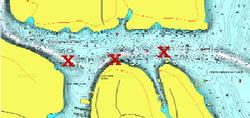 Reservoir Type: Lowland/big river” border=”1″ align=”left” />Target area: Deep feeder channels leading into spawning areas
Reservoir Type: Lowland/big river” border=”1″ align=”left” />Target area: Deep feeder channels leading into spawning areas
Reservoir type: Lowland/big river
Situational analysis: Start with well-known spawning bays and work backward into the creek toward the main lake. Find the feeder supply leading into the spawning bay, and you’ve found where bass hang out when the water temperature plummets.
Unlike Shuffield’s tactics for the backs of creeks, which are often shallow, on Neal’s home turf of Chickamauga, local anglers catch bass 30 to 35 feet deep on this pattern, and the hottest bite can range from 15 to 40 feet deep. It usually takes off once water temperatures drop below about 44 degrees. But the real key to dialing it in isn’t the depth, but rather it’s finding a bend or swing in the channel.
“Sometimes they’re in the bottom of the ditches or on the sides,” Neal says. “The fish group up. You can actually see them on the graph, no problem. Finding the turns isn’t too difficult on Chickamauga. Everything is a whole lot more defined to me than it is on, say, Kentucky Lake.”
Attack plan: The search starts with electronics. Neal works back and forth across the ditch or channel so he can scan the top, sides and bottom of the structure. Schools can be large in winter – 10 to 15 fish in a cluster. Bass often situate at similar depth from one spot to another.
“I’ll use both down- and side-imaging,” Neal says. “I use the side-imaging to see the bait and where it’s relating, because in the wintertime bass are just about all bait-related. To actually see the schools of bass I’ll use the 2-D sonar.”
Winter weaponry: Neal isn’t much for dropping vertically on schools of bass. He prefers to cast a shaky head, grub or Silver Buddy blade bait into the school.
“With the Silver Buddy, I’ll pump it up, let it hit the bottom, pump it up and let it go back,” Neal says. “The grub I just throw out there, let it hit the bottom, reel it 10 or 12 cranks, and let it fall back. I try to maintain a retrieve 2 or 3 feet off bottom.”
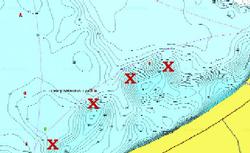 Reservoir Type: All” border=”1″ align=”left” />Target area: Steep-dropping points and humps
Reservoir Type: All” border=”1″ align=”left” />Target area: Steep-dropping points and humps
Reservoir type: All
Situational analysis: It’s all about the drop when evaluating points and humps in winter. Neal likes to set up so he can hold the boat in 25 or 30 feet of water and cast up into 5 to 10 feet.
“I like something steep in the wintertime,” Neal adds. “I don’t like a slow-tapering point. They want that deep water to relate to. This is a drawdown lake [Chickamauga], so I don’t know if that has something to do with it. They like to have some deeper water nearby.”
Attack plan: Neal’s attack begins with an electronics scan. He idles alongside structure at 3 1/2 to 4 mph and watches his side-viewing sonar to locate suspended baitfish. When he finds it, he drops the trolling motor and backtracks the trail on his GPS while casting.
The technique is designed to lure suspended bass, and it’s based on the depth on top of the point.
“If it’s 5 feet on top, then after my bait comes off the break I’ll keep it in 5 feet,” Neal explains. “If it’s 10 feet I try to maintain the bait at 10 feet. I think they suspend at the same depth as the top, but they don’t stay on it.”
Winter weaponry: Neal’s go-to presentation on points and humps has been an umbrella rig with two blades on each arm, although swapping the blades for “dummy” swimbaits works well too. Jerkbaits and single swimbaits are also good lure choices in situations when an umbrella rig can’t be used.